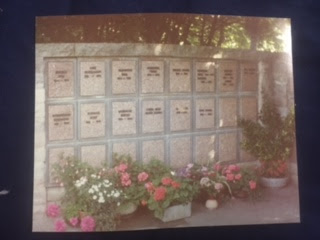 |
| The lagoon in the middle of Magnolia |
We braved mosquito bites and talkative cab drivers to cross over to the other side and explore a time where death was used as a way to immortalize the living with grand statues and burial places unlike the lawn markers of today. This breath taking cemetery has almost every kind of grave marker known to man with some being considered modern, marvelous monuments as there really is no classification for them.
 |
| The office at Magnolia |
It also has an old house that is used as the office for the cemetery that was built in its early days.
At Magnolia there are many different monuments it is hard to just pick three to talk about but I will narrow down the best and explain some things about them.
 |
The sun smiled down on the Smith pyramid that day.
|
This mauseloum that is in the shape of shape a pyramid is by far the best in my opinion. Belonging to the family of William Burroughs Smith, a prominent banker in Charleston during the late 1800s. His pyramid is roughly over 100 years old and has been vandalized sadly, however you can see that new life emerged on the pyramid with grass and a tree poking out from the top. The idea of a pyramid came from his daughters when he died, I personally think the shape goes right along with his career as pyramids are prominent on our currency.
The Elbert P. Jones Monument is another of unprecedented beauty at Magnolia Cemetery. The monument features four different angles carved and paced on each side showing different emotions over the plot. Jones was only $6,500 dollars during his day, a sum of almost $300,000 today would be needed to recreate this masterpiece. He was a prominent business man in San Francisco but later moved to Charleston just a year before his death in 1852. His monument also has a Bible verse under the hands of on angel reading "Man that is born of a woman is of few days and full of trouble."
This monument to Sergeant James Brown Boyd just beat out some for the last space in this countdown of magnificent monuments at Magnolia Cemetery. He was a Confederate War solider tat fought in the bloodiest battle of the war at Sharpsburg in 1862. He was part of the Palmetto Guards, as seen by the palmetto fawns on his column. He also has flag crossed around the palmetto fawns that show he was a decorated war veteran. He was killed at only 22 during the war and had no other family other than a distant cousin at the time of his death.
As our visit to Magnolia Cemetery drew to a close, the whole class was over taken with its beauty and stood in awe, while slapping mosquitoes, looking at the beauty that is Magnolia Cemetery. We had such a great time at the cemetery and nothing could compare in the other sites we visit. Thanks to Professor Harwood's book In the Arms of Angels: Magnolia Cemetery for providing the information, as well as, findagrave which also provided information used in the post.
 |
| Just a big portion of the nine that attended from left to right: Beth, Aline, Hunter, Myself, Megan, and Zack |














